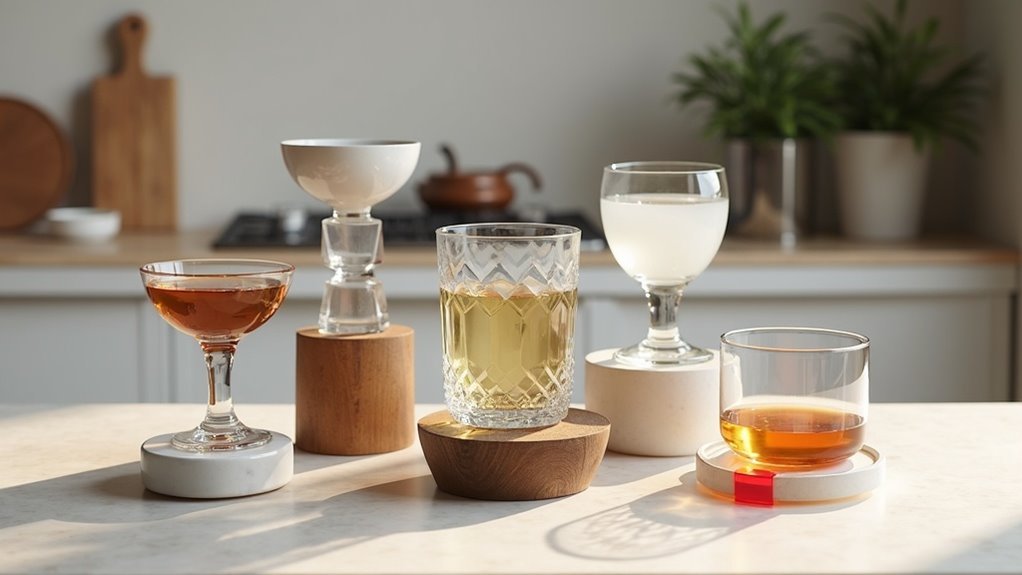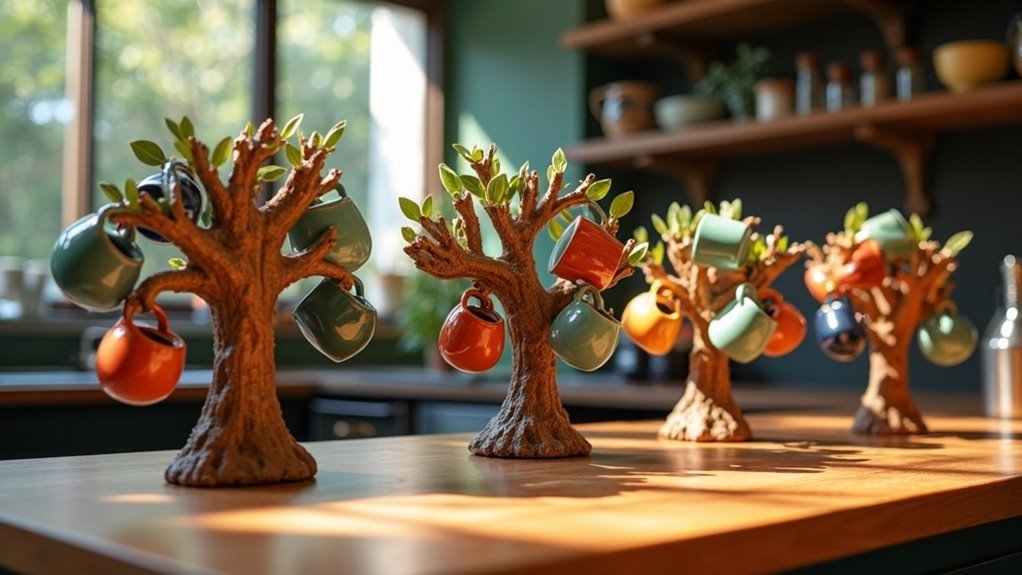Batian coffee is a high-yield, disease-resistant varietal developed in Kenya by the Coffee Research Institute. Launched in 2010, it combines traits from SL-28 and SL-34 to enhance both productivity and cup quality. Expect impressive yields of up to 5 tons per hectare, with production beginning just two years after planting. This varietal is celebrated for its distinctive flavors, showcasing bright acidity and tropical notes. As you delve deeper into the world of Batian coffee, you’ll discover even more benefits and nuances that make it an exceptional choice for coffee enthusiasts.
Key Takeaways
- Batian coffee is a disease-resistant varietal developed in Kenya, officially launched on September 8, 2010, by the Coffee Research Institute.
- This remarkable varietal combines traits from the well-regarded SL-28 and SL-34 varieties, with a focus on achieving high yields and exceptional cup quality.
- Batian coffee is characterized by its large beans, capable of yielding up to 5 tons per hectare, and begins production within just two years of planting.
- The flavor profile of Batian coffee features a bright, juicy acidity with delightful notes reminiscent of oranges and tangerines, culminating in a clean, lingering finish that coffee enthusiasts cherish.
- Its notable high disease resistance minimizes the need for chemical treatments, making Batian coffee not only economically viable but also a champion of sustainable farming practices in the coffee industry.
Origin of Batian Coffee
Batian coffee, developed by the Coffee Research Institute, was launched on September 8, 2010, in response to the significant challenges faced by coffee growers due to diseases.
This innovative hybrid was created to be disease-resistant by combining the desirable traits of the celebrated Kenyan varieties SL-28 and SL-34. This careful genetic blending not only enhances disease resistance but also ensures high yields, effectively addressing the urgent issues stemming from coffee disease outbreaks.
Named after the highest peak of Mount Kenya, Batian coffee embodies local heritage and flourishes in Kenya’s ideal growing conditions. Its introduction represents a crucial effort to maintain sustainable coffee production in the region.
Outstanding Characteristics of Batian Coffee Variety
The Batian coffee variety is exceptional not only for its impressive disease resistance and high yield potential but also for its unique characteristics that attract both growers and coffee enthusiasts. This tall variety is known for producing large beans and can yield up to 5 tons of clean coffee per hectare under optimal conditions. It starts producing in just two years, which is a significant advantage over traditional varieties. Batian coffee is notably resistant to Coffee Berry Disease and shows intermediate resistance to Coffee Leaf Rust. Developed from renowned Kenyan varieties, it harmoniously blends high productivity with superb cup quality.
| Characteristic | Detail |
|---|---|
| Yield Potential | Up to 5 tons/ha |
| Production Start | 2 years |
| Disease Resistance | Resistant to Coffee Berry Disease |
| Leaf Rust Resistance | Intermediate |
| Cup Quality | Excellent, with a rustic mountain flavor |
Batian Coffee’s Flavor Profile
A mesmerizing flavor profile distinguishes Batian coffee, appealing to both growers and enthusiasts alike.
Grown at higher elevations, this disease-resistant hybrid showcases a unique blend of complex fruit notes. You’ll experience bright, juicy acidity paired with the sweetness of ripe fruits, reminiscent of oranges and tangerines. The coffee’s clean, lingering finish enhances its appeal, particularly in the specialty market.
Innovative processing methods like carbonic maceration and natural lactic fermentation further enrich the tasting experience, revealing notes of pineapple, Rainier cherry, coconut cream, and vanilla.
Batian coffee truly stands out as a compelling option among global coffee varieties.
High Yield and Agronomic Advantages
Batian coffee’s disease resistance provides essential agronomic advantages, minimizing the need for chemical controls and decreasing production expenses.
Furthermore, its capacity to start yielding in as little as two years allows for quicker revenue generation compared to traditional coffee varieties.
These combined factors underscore Batian’s potential for high yields and economic viability across different coffee-growing regions.
Disease Resistance Benefits
When exploring coffee varietals that optimize yield and disease resistance, Batian emerges as a top contender due to its impressive attributes.
Here are some essential benefits:
- Exceptional yield potential of up to 5 tons of clean coffee per hectare.
- Strong resistance to Coffee Berry Disease, reducing the need for chemical treatments.
- Intermediate resistance to Coffee Leaf Rust, contributing to overall disease resilience.
- A deep root system that enhances adaptability to a variety of growing conditions.
These benefits not only help reduce production costs but also promote a more sustainable approach to coffee farming, positioning Batian as an excellent choice for farmers seeking both quality and durability in their crops.
Early Production Timeline
When it comes to coffee production, the early timeline of Batian coffee offers significant advantages that can transform farming strategies.
This varietal begins producing in just two years, compared to the three years typical for traditional varieties.
With a high yield potential of up to 5 tons of clean coffee per hectare, Batian coffee’s adaptability is further enhanced by its tall growth habit and deep root structure.
Its resistance to coffee berry disease and intermediate resistance to coffee leaf rust minimize chemical use, lowering production costs while optimizing performance, especially at medium to high altitudes where conditions are ideal for yield and quality.
Disease Resistance and Resilience
When considering disease resistance in Batian coffee, it exhibits intermediate resistance to coffee leaf rust, which is a significant advantage compared to many traditional varieties.
However, it’s crucial to recognize that this varietal shows susceptibility to nematodes, presenting challenges that require proper management.
Understanding these dynamics is essential for optimizing both yield and sustainability in coffee production.
Coffee Leaf Rust Resistance
Batian coffee is notable for its intermediate resistance to coffee leaf rust, a significant disease that poses a threat to coffee production globally. This resistance provides several key benefits:
- High Yield Potential: Batian coffee merges disease tolerance with high productivity.
- Cost Savings: Farmers can reduce production costs as they may not need chemical treatments for disease management.
- Robust Performance: Tested at 23 locations across 15 countries, Batian has shown resilience in a variety of agricultural conditions.
- Additional Resistance: In addition to coffee leaf rust, Batian also exhibits resistance to Coffee Berry Disease (CBD), which further enhances its overall hardiness (Coffee Research Institute – CRI).
These attributes make Batian an excellent choice for coffee farmers.
Nematode Susceptibility Issues
Although Batian coffee showcases several advantages, including robust resistance to coffee leaf rust and Coffee Berry Disease, it unfortunately faces challenges with nematode susceptibility.
These nematodes can severely impact root health, ultimately compromising the plant’s vigor and yield. While Batian exhibits overall disease resilience, its susceptibility to nematodes poses a significant risk for coffee growers.
Performance evaluations across 23 sites in 15 countries have confirmed its adaptability, yet the genetic traits that provide resistance to other diseases don’t extend to nematodes.
As a result, understanding and managing this vulnerability is essential for optimizing Batian coffee’s potential in diverse agricultural environments.
Comparison With Other Coffee Varieties
While many coffee varieties have their strengths and weaknesses, Batian coffee stands out due to its unique combination of traits derived from SL28, SL34, and other varieties.
Here’s how Batian compares to others:
Batian coffee excels in disease resistance, yield timeline, flavor, and adaptability, setting it apart from other varieties.
- Disease Resistance: Batian’s immunity to Coffee Berry Disease and coffee leaf rust reduces pesticide costs, making it a more sustainable choice for coffee farmers.
- Yield Timeline: Batian matures in just two years, whereas Ruiru 11 takes three years to reach maturity, allowing farmers to benefit from a quicker return on investment.
- Flavor Profile: Batian’s larger beans deliver a superior taste, often outperforming SL varieties during cupping sessions, which is crucial for those seeking high-quality coffee.
- Adaptability: Batian thrives in a variety of agro-ecological zones, unlike specific SL varieties that may have stricter growing conditions.
This versatility not only enhances the quality of the coffee produced but also significantly boosts profitability for farmers.
Future Prospects for Batian Coffee
As the coffee industry continues to evolve, Batian coffee is poised to stand out as a leading varietal in Kenyan production. With an impressive yield potential of up to 5 tons per hectare and significant resistance to diseases, Batian coffee presents a compelling choice for farmers. Its ability to produce early, starting from the second year, enables growers to benefit economically sooner. Ongoing research is focused on enhancing Batian’s adaptability across various agro-ecological zones, which supports sustainable farming practices. The following table outlines the key aspects of Batian’s promising future:
| Aspect | Benefits | Importance |
|---|---|---|
| Yield | Up to 5 tons/hectare | Economic viability |
| Disease Resistance | High | Crop security |
| Early Production | From second year | Faster returns |
| Adaptability | Diverse agro-ecological zones | Climate resilience |
| Market Acceptance | Specialty coffee recognition | Global competitiveness |








